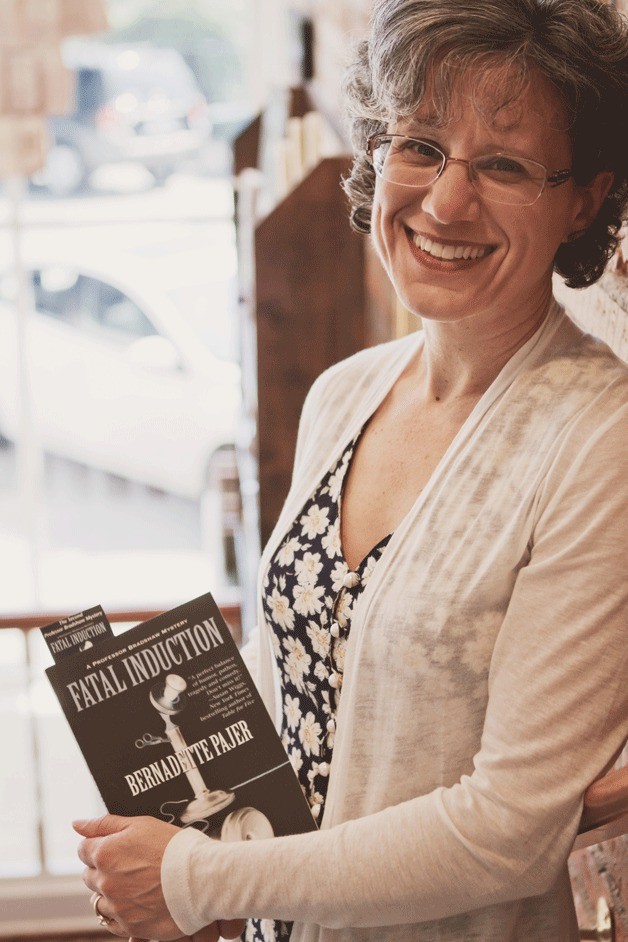Bernadette Pajer is back again with her Professor Bradshaw Mysteries.
At this point in the series, Professor Benjamin Bradshaw, a professor of electrical engineering at the University of Washington, has a well-established reputation solving mysteries with an electrical twist.
And in Pajer’s third mystery “Capacity for Murder,” Bradshaw is called to Washington’s Pacific beachside to investigate an electrical disaster at Dr. Hornsby’s Healing Sands Sanitarium.
Set in 1903, sanitariums, which could be described as health resorts, are a popular phenomena at the time. And Healing Sands is a modest, intimate compound with a main house and several beach cottages set near the real town of Pacific Beach.
Dr. Hornsby, who runs the facility, is not an obscene practitioner. He prescribes the standard methods of the time including a balanced diet, exercise, fresh air and rest.
But as it is the era of electro-therapy, he also uses a standard regimen of electro-medical devices on his patients. No one has ever died at Healing Sands until an electrical “accident” leaves only a handful of suspects.
But Bradshaw knows it’s no accident.
Pajer started writing the series more than a decade ago. She has gone through revisions and life events during that time. But the stories and characters of the Professor Bradshaw Mysteries have become like a place to which Pajer can always come home.
And while enjoying another camping trip at her family’s usual spot at Pacific Beach State Park, the faint wisps of Bradshaw’s next adventure came to her.
“There I see beautifully, perfect, geometric patterns in the sand, and I just knew it was a place Bradshaw would love,” she said.
Pajer has always been interested in math, science and engineering. In fact, she spent her first stint at the University of Washington studying pre-engineering before she met her husband.
But it was the idea of missing a whole generation of technological advancements that swept her into the idea of Professor Bradshaw.
“In 1963, I was born into a world of astronauts and magic,” Pajer explained. “I just accepted that people can fly. The amazing transformations in science occurred before I was born.
“Just 60 years earlier, none of that was thought possible.”
So she took her character, Professor Bradshaw and set him in 1903.
For “Capacity for Murder” she had time, 1903, and she had her “who,” Bradshaw and her formulating ideas of a
Dr. Hornsby. She also discovered the perfect place, Washington’s Pacific shore.
But what she didn’t have was “how.” Getting Bradshaw from Seattle’s UW campus to the ocean was going to be a research project.
The area at the time was remote and the population next to nothing. In Pajer’s research she found there were only a few ways to travel to the beach, the most common one being the train to Gray’s Harbor, then hiking the remaining 15 miles. This presented a problem, since not only did hiking 15 miles to a health resort sound unreasonable for the types of visitors a health resort would attract, but trains didn’t come about until 1905 in Washington, two years after Bradshaw’s investigation at Healing Sands.
So Pajer kept digging until she found what she calls a treasure: Iron Springs Hotel.
Another common way to travel was by horse and wagon up the beach from a town today called Oyehut. And it was this way that many visitors trekked to Dr. Chase’s Iron Springs Hotel, now called Iron Springs Resort, which was located just south of her planned setting for the fictional Healing Sands.
In the early 1900s, Iron Springs was a sanitarium almost exactly as Pajer envisioned Healing Sands to be with a main house and cabins. Dr. Chase was even known to use electro-medical methods using what was called “Professor Beckwith’s ozone battery.”
A treasure within a historical treasure, “Capacity for Murder” takes its readers back in time and to places Bainbridge Islanders can recognize.
Pajer will be aboard the 4:40 p.m. Seattle-to-Bainbridge Ferry on Thursday, May 23 to talk about history and mystery for the Books Afloat! Ferry Tale series.
It will be followed by a book signing at Eagle Harbor Book Co. from
7:30 to 8:30 p.m.


